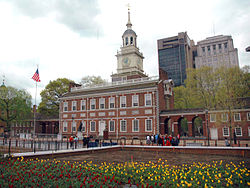French Arms Tavern

| This article is part of a series on the |
| United States Continental Congress |
|---|
 |
| Predecessors |
| First Continental Congress |
| Second Continental Congress |
| Congress of the Confederation |
| Members |
| Related |
| |
The French Arms Tavern (also known as the Thirteen Stars, Blazing Star Tavern, City Tavern and City Hotel) was a structure in Trenton, New Jersey, that served as the capitol of the United States and meeting place of the Congress of the Confederation from November 1, 1784, to December 24, 1784.[1] The building was located at the southwest corner of King (now Warren) and Second (now State) Streets from 1730 until 1837 when it was torn down.
History
[edit]Historian William Backes described the original building as "a stone house two stories high with gable roof. The building measured 45 feet front by 53 feet in depth, with a kitchen in the rear containing rooms for servants on the second floor. It was the handsomest and most commodious house in Trenton in its day."[2] From 1740 until 1742 it was the official residence of Royal Governor Lewis Morris.[2]
During the Second Battle of Trenton, it was involved in "one of the most brutal military murders" of the New Jersey campaign when Reverend John Rosburgh was bayonetted to death by Hessian troops.[3]
From April 1, 1780, until February 1781 it was known as the Thirteen Stars and run by Jacob Bergen. In 1781, John Cape, upon becoming the proprietor, changed the name to the French and Indian Arms, commonly referred to as the French Arms Tavern. In 1783, Jacob Bergen returned to operate the tavern again. It was extensively renovated in 1784, combining the rooms on the first floor into one room known as the Long Room.[4] Moore Furman, James Ewing, and Conrad Knotts signed a lease with Bergen for annual payment of 150 pounds for "the use and purpose of Congress of the United States to set in."[5]
It continued to be known as the French Arms Tavern until being leased to Francis Witt on January 4, 1785 and renamed the Blazing Star.
From December 11 to December 18, 1787, it served as the meeting location for the New Jersey ratification convention for the United States Constitution.[6]
On April 1, 1789, Henry Drake took over the tavern and renamed it the City Tavern. It was here on April 21, 1789, that George Washington, journeying to New York for his inauguration, dined after being received by the citizens of Trenton at the Assunpink Creek Bridge.[5][7]
In 1836, the First Mechanics and Manufacturers Bank purchased the property, tore down the tavern and constructed a new two-story building on the site.[8] The building is currently occupied by a branch of Wells Fargo.
Gallery
[edit]- Plaque commemorating New Jersey's ratification of the United States Constitution on the One West State Street building now at this site
- One West State Street building on this site
- Bronze doors at One West State Street, featuring bas-relief portraits of George Washington, Marquis de Lafayette, Alexander Hamilton, and Benjamin Franklin.
References
[edit]- ^ "French Arms Tavern". Buildings of the Department of State - Buildings - Department History - Office of the Historian. Retrieved 16 October 2017.
- ^ a b Backes, William (1929). "VI. Landmarks, Taverns, Markets and Fairs". A History of Trenton, 1679-1929. Vol. I. Princeton, NJ: Princeton University Press.
- ^ Pierce, Arthur D. (April 1984). Smugglers' Woods: Jaunts and Journeys in Colonial and Revolutionary New Jersey. New Brunswick, NJ: Rutgers University Press. p. 213. ISBN 978-0-8135-0444-5.
- ^ Sines, John (1929). "I. Finance". A History of Trenton, 1679-1929. Vol. I. Princeton, NJ: Princeton University Press. p. 187.
- ^ a b "SITE OF 1784 CONGRESS HALL FOUND IN TRENTON; Original Lease Dug Up by Dr. Carlos E. Godfrey". The New York Times. December 19, 1906. Retrieved 2008-06-04.
- ^ Carney, Leo (1987-09-27). "BICENTENNIAL EXHIBIT SHOWS ROLE OF STATE". The New York Times.
- ^ Raum, John O. (1871). History of the City of Trenton, New Jersey: Embracing a Period of Nearly Two Hundred Years. Trenton, NJ: W. T. Nicholson & Co. pp. 184.
- ^ Crown, Cathleen; Rogers, Carol (March 2000). Trenton. Images of America. Charleston, SC: Arcadia Publishing. p. 24. ISBN 978-0-7385-3776-4.


 French
French Deutsch
Deutsch


